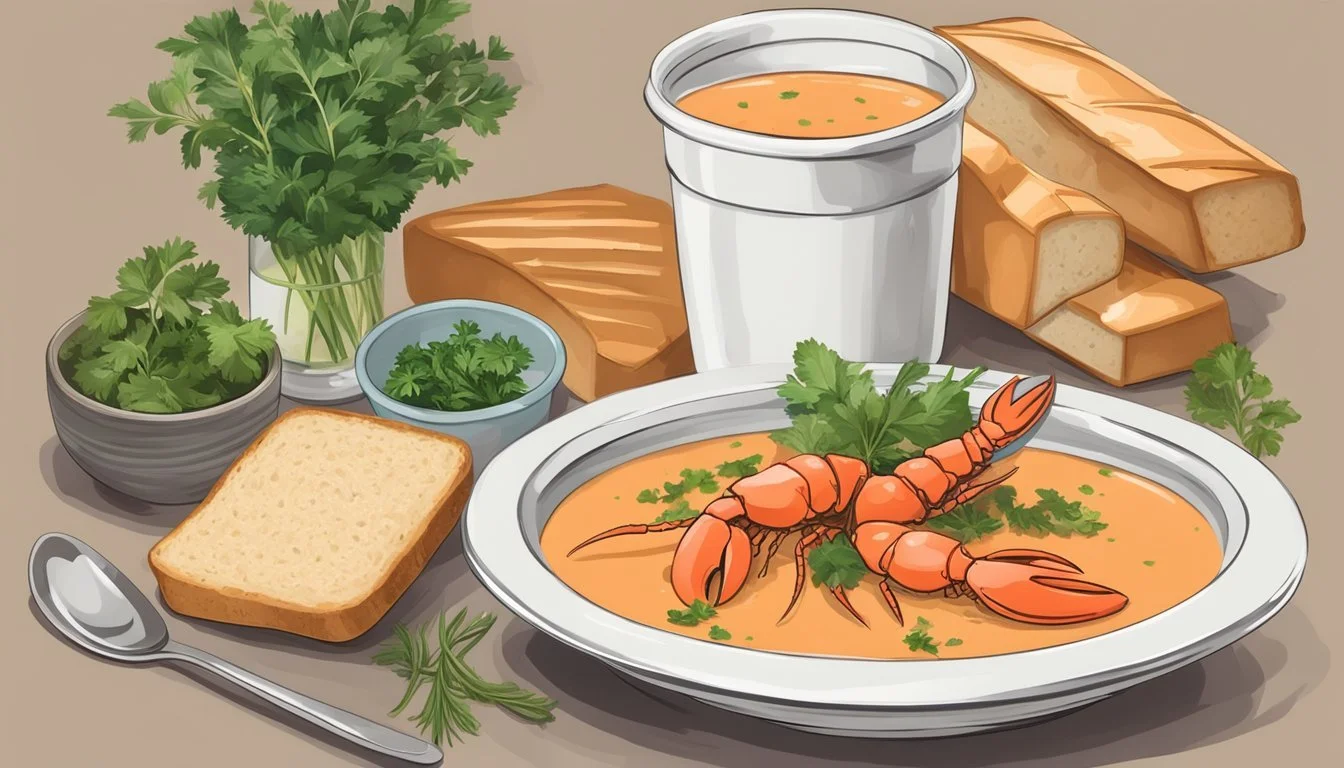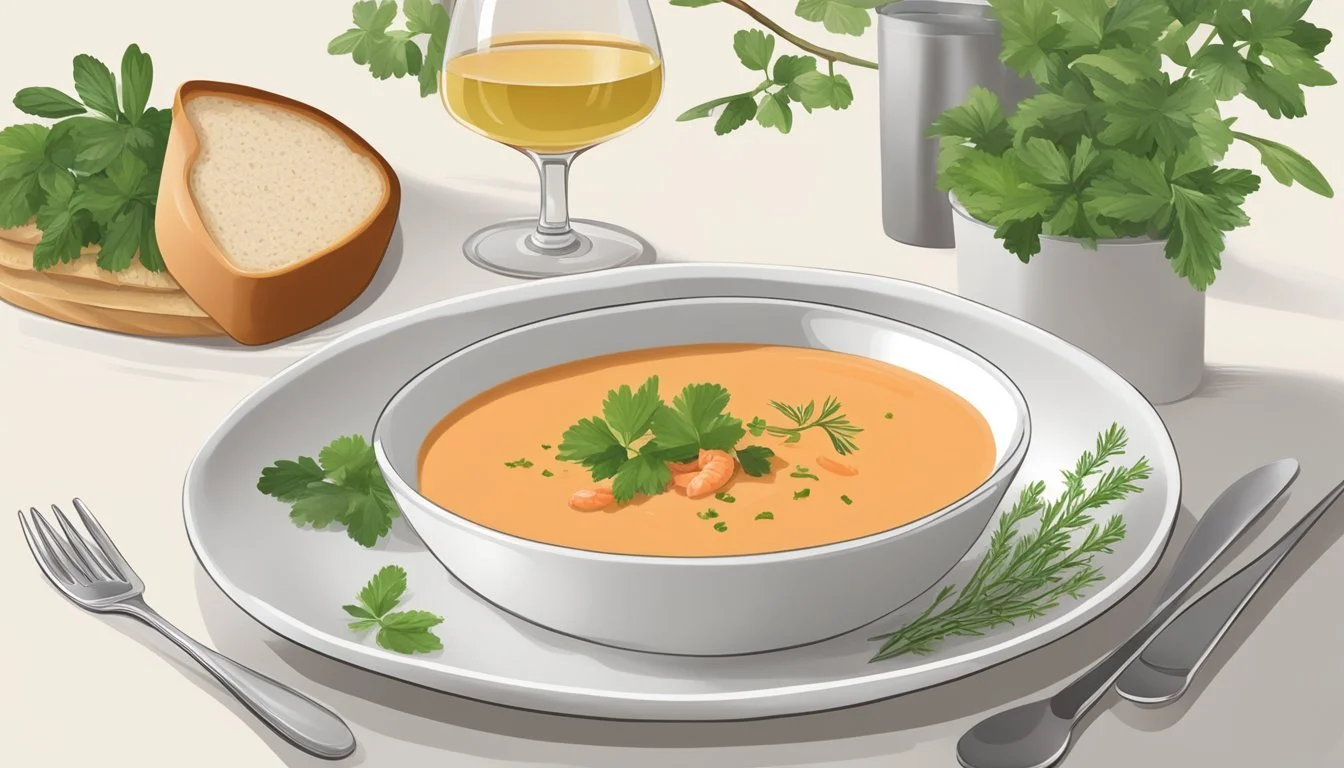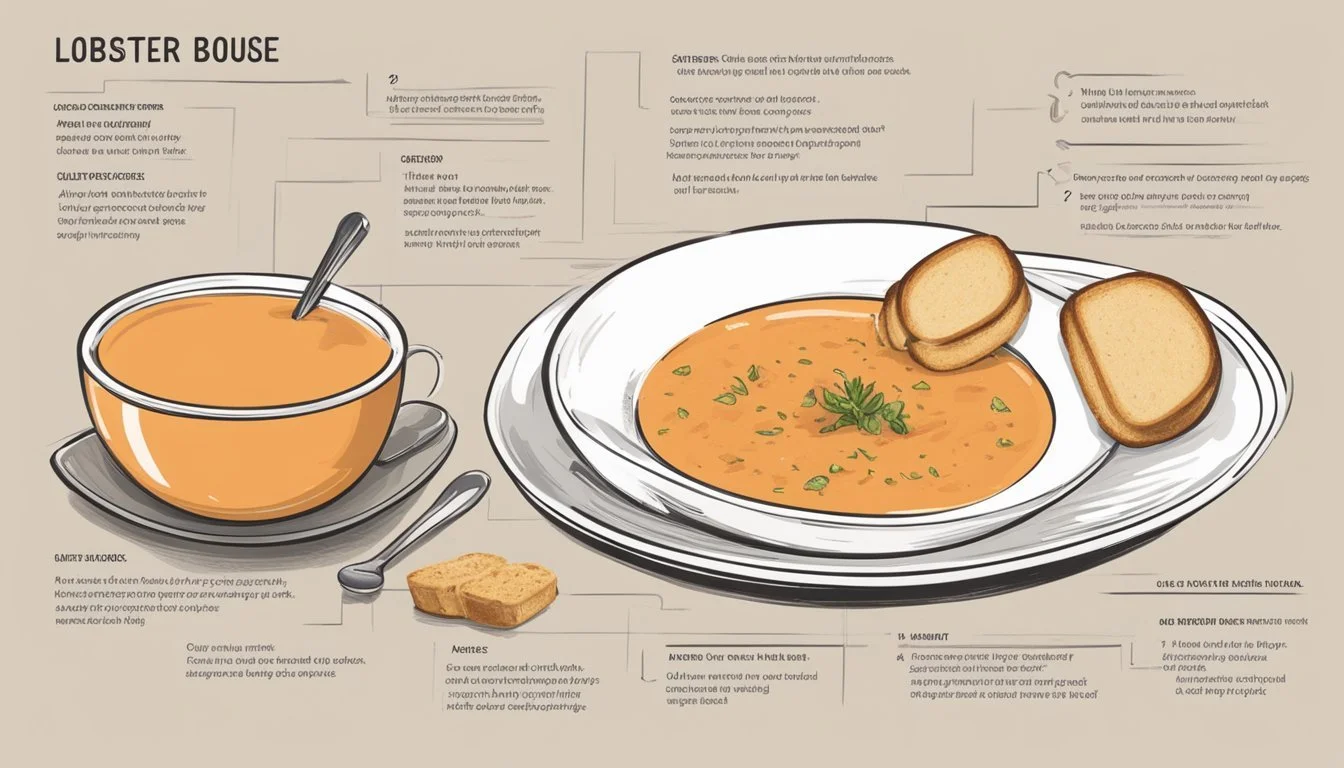Is Lobster Bisque Gluten-Free?
Unveiling the Facts about This Classic Soup
When it comes to seafood soups, lobster bisque is often celebrated for its rich flavor and creamy texture. Traditional lobster (What wine goes well with lobster?) bisque is a smooth, velvety soup that usually consists of a stock made from lobster shells, cream, and a mixture of vegetables and seasonings. The question of whether or not lobster bisque is gluten-free depends greatly on the specific recipe used, as the thickener plays a critical role.
In many recipes, thickening agents such as wheat flour are commonly used, which contain gluten. However, for those adhering to a gluten-free diet, alternative thickeners like sweet rice flour or cornstarch can be used effectively. Lobster meat itself is naturally gluten-free, but the inclusion of any gluten-containing ingredients during the cooking process would render the bisque unsuitable for individuals with gluten sensitivity or celiac disease.
Those searching for a gluten-free lobster bisque should look for recipes that specifically avoid gluten-containing ingredients or should be prepared to modify traditional recipes with gluten-free alternatives. It's important for consumers to read labels carefully or inquire about ingredients when dining out, as gluten can be present in unexpected forms. Consequently, while gluten-free lobster bisque is attainable, careful attention to the recipe and preparation is paramount.
Understanding Bisque
In the domain of refined cuisine, bisque holds a special place as a rich, creamy, and smooth seafood-based soup traditionally thickened with rice.
Defining Bisque
A bisque is a thick, creamy soup that is pureed to achieve a smooth and velvety consistency. Originating from French cuisine, it is often made with crustaceans such as lobster, shrimp, crab (What wine goes well with crab?), or crayfish. The hallmark of a bisque is its method of using the seafood shells, which are simmered to extract maximum flavor, and then often thickened with rice, which is subsequently pureed into the soup base to create its signature texture.
Bisque Vs. Soup
While all bisques are a form of soup, not all soups (What wine goes well with soups?) are bisques. The primary distinctions between bisques and the broader category of soups include:
Texture: Bisques are pureed to a smooth texture while soups can range from brothy to chunky.
Base: Bisques typically have a seafood base and use the shells of the crustaceans for a deep flavor, whereas soups can be made from a variety of bases, such as vegetables, meat, or poultry.
Thickness: Bisques are thickened using rice or a roux, contributing to their creamy consistency; soups may not be thickened at all or can be thickened using a variety of other agents.
Creaminess: Bisques almost always include cream or a cream alternative to achieve a rich, creamy profile, a step not necessary in many other soup recipes.
Lobster Bisque Ingredients
Crafting a sumptuous lobster bisque involves a symphony of select ingredients that blend to create its signature luxurious flavor and texture. Each component plays a crucial role from the heart of the dish—the lobster, to the foundation of cream and dairy, all intertwined with the aromatic profile of vegetables and herbs, finished with an exacting selection of spices.
Lobster and Seafood
Lobster: At the core of the bisque, lobster tails are typically boiled and the meat removed. Some recipes also recommend reserving the shells for adding depth to the stock.
Shells: Lobster, shrimp, or crab shells contribute rich flavor when simmered to create the bisque’s foundation.
Cream and Dairy
Heavy Cream: This adds a creamy texture and richness essential to the bisque's character.
Butter: It's sautéed with vegetables to start the base and may also be used to enrich the final soup.
Vegetables and Aromatics
Onion, Celery & Carrot: These are often softened in butter to begin the bisque's flavor base.
Garlic: Cloves of garlic are sautéed until fragrant, complementing the other aromatics.
Bay Leaf & Thyme: Herbs that provide an underlying earthiness and complexity to the flavor profile.
Seasonings and Spices
Tomato Paste: Deepens the color and adds a hint of tangy sweetness.
Black Pepper & Cayenne Pepper: Adjusted to taste, they balance warmth and spiciness.
Paprika: Lends a subtle smokiness and enhances the bisque’s vibrant hue.
Old Bay Seasoning: Some cooks incorporate it for an additional layer of zest.
Sea Salt: Elevates all flavor components.
The ingredients in a traditional lobster bisque are not inherently gluten-free due to the use of flour as a thickener. However, substitutions like sweet rice flour can be used to cater to gluten-free dietary needs.
Preparation of Lobster Bisque
Preparing Lobster Bisque involves a series of meticulous steps to ensure a rich texture and creamy soup result. Precision in cooking techniques, choice of thickening agents, and final touches are essential in creating a delicious homemade bisque that is easy to make.
Cooking Techniques
Lobster bisque starts with boiling lobster tails until they are cooked through and bright red, which usually takes about 5 minutes. Once done, the meat is removed from the shells, and the shells may be used later to infuse the stock with more flavors. It is important to reserve the cooking liquid as it forms the base of the soup recipe, encapsulating the essence of lobster.
Thickening the Bisque
Traditionally, lobster bisque is thickened with rice flour to maintain a gluten-free status. A roux is created by cooking the rice flour with butter and a mixture of vegetables such as diced celery and scallions. The mixture is stirred over medium heat to prevent lump formation, resulting in a smooth base before adding the stock to the saucepan. This process gives the bisque its characteristically rich texture without the use of gluten-containing thickeners.
Final Touches
After the stock is added and the bisque simmers, the soup is blended until smooth, and the cooked lobster meat is returned to the pot. Cream is added for a final touch, enriching the texture and flavor of the soup, resulting in a velvety and creamy soup that balances the distinctive taste of lobster with the cream's subtle sweetness. Seasoning adjustments are made to taste before serving to ensure a delightful culinary experience.
Nutritional Information
When considering the nutritional content of lobster bisque, it is particularly important to pay attention to its caloric content and the variety of beneficial nutrients it contains. These factors together can provide a comprehensive view of the potential health benefits and considerations associated with consuming this dish.
Caloric Content
Lobster bisque is a rich and creamy soup, which often results in a high caloric count per serving. The exact number of calories can vary depending on the recipe; however, an average cup of homemade lobster bisque may contain approximately 200-400 calories, primarily from cream and butter.
Beneficial Nutrients
Despite its richness, lobster bisque can be a source of several beneficial nutrients:
Calcium & Potassium: These minerals are essential for bone health and blood pressure regulation. Lobster bisque can contribute to the daily required intake of calcium and potassium.
Omega-3 Fatty Acids: Lobster contains omega-3 fatty acids, which are known for their heart health benefits and anti-inflammatory properties.
Zinc: As a seafood, lobster provides a good amount of zinc, an important nutrient for immune function and metabolism.
Protein: Lobster is a good source of lean protein, necessary for muscle repair and growth.
Please note that the presence of these nutrients can be diminished if the bisque is made with a significant amount of unhealthy ingredients or added sodium.
Consumers should be mindful that while lobster bisque can offer some nutritional benefits, moderation is key due to its potential high sodium and caloric content.
Understanding Gluten-Free Diets
A gluten-free diet excludes the protein gluten, found in grains such as wheat, barley, and rye. Such a diet is crucial for managing medical conditions associated with gluten.
What Does Gluten-Free Mean?
Being gluten-free means eliminating gluten, a group of proteins present in wheat and related grains, including barley and rye. Gluten consumption can cause health issues for people with celiac disease, gluten sensitivity, or wheat allergy. Gluten-free diets involve substituting gluten-containing foods with alternatives like rice, corn, or gluten-free flours.
Benefits of a Gluten-Free Diet
Adopting a gluten-free diet can offer significant benefits, particularly for individuals with celiac disease or gluten sensitivity. Relief from digestive symptoms is one of the most immediate benefits they may observe. Additionally, for those also focusing on dairy-free, paleo, keto, or Whole30 diets, a gluten-free approach can often be compatible and supportive. Below is a brief overview of these diet compatibilities:
Dairy-Free: Eliminates dairy products; possible overlap with gluten-free if dairy triggers similar sensitivities.
Paleo: Focuses on eating whole, unprocessed foods; naturally gluten-free as it excludes grains.
Keto: Aims to reduce carbohydrate intake; gluten-containing foods are typically high in carbs and thus are excluded.
Whole30: A 30-day diet that cuts out sugar, alcohol, grains, legumes, soy, and dairy; emphasizes whole foods and is inherently gluten-free during the period.
People on a gluten-free diet can experience improved health, energy levels, and weight management. However, it's essential for individuals to seek nutrient-rich alternatives as they navigate a gluten-free lifestyle to ensure a balanced diet.
Gluten-Free Lobster Bisque
Creating a gluten-free lobster bisque involves selecting the right thickening agents and ensuring there is no cross-contamination. The use of gluten-free alternatives such as rice flour or cornstarch can achieve the traditional bisque texture without the gluten.
Alternative Ingredients
For a gluten-free lobster bisque, traditional wheat flour must be replaced with gluten-free alternatives. Suitable options include:
Rice flour: A common substitute, rice flour disperses well into the bisque for a smooth finish.
Cornstarch: It acts as an excellent thickener and gives the bisque a glossy appearance.
Almond flour: For a nuttier flavor and thicker consistency, almond flour is an effective thickener.
Xanthan gum: A pinch of xanthan gum can stabilize the bisque without altering the flavor.
In addition to the thickening agents, other ingredients should be checked for gluten content. Broth or stocks, for instance, can be replaced with certified gluten-free chicken stock or vegetable stock. To add creaminess without dairy, one might consider coconut milk as a flavorful alternative.
Avoiding Cross-Contamination
One must pay careful attention to avoid gluten cross-contamination, which can occur if gluten-free foods come into contact with gluten-containing substances. To prevent this:
Use separate utensils and cookware dedicated to gluten-free cooking.
Thoroughly clean all surfaces and equipment before use.
Always check labels for certification or indications of 'gluten-free' to ensure all ingredients meet standards.
By adhering to these guidelines, one can prepare a delicious and safe gluten-free lobster bisque.
Lobster Bisque Recipes
Lobster bisque is a smooth, creamy, highly seasoned soup of French origin, classically based on a strained broth of crustaceans. It can be found in fine dining as well as in home cooking. Below are two variations of this beloved dish.
Traditional Lobster Bisque
The traditional lobster bisque involves creating a rich stock made from lobster shells and adding ingredients like onion, celery, and garlic to form a flavor base. This base is usually thickened with a roux—an equal mixture of flour and fat. The soup often includes heavy cream and a small amount of brandy or sherry for additional depth of flavor. The cooking process involves several steps:
Boil lobster tails in water until they are cooked through and bright red.
Reserve the cooking liquid as it contains essential flavors.
Sauté vegetables such as onions, celery, and garlic in butter.
Thicken the soup with a roux made of flour and add it to the stock.
Blend until smooth, and finish with cream and brandy or sherry.
Gluten-Free Variations
For those seeking gluten-free options, several adjustments can be made to the traditional recipe without sacrificing flavor. To replace the flour typically used in the roux:
Sweet rice flour can be used as a thickening agent, which blends smoothly into the soup without creating lumps.
Another option is chickpea flour, which can be sautéed with the aromatics to form a gluten-free roux.
The following list outlines the steps to create a gluten-free lobster bisque:
Boil lobster as with the traditional method and reserve the liquid.
Cook aromatics like scallions and celery in butter; then add the chosen gluten-free flour.
Puree the soup after cooking to achieve the classic smooth texture.
Simmer with gluten-free stock and add the cooked lobster meat at the end.
The result is a delicious seafood soup that satisfies the cravings for seafood lovers and those following a gluten-free diet alike. Whether one opts for a traditional or gluten-free version, lobster bisque remains a sophisticated and enduring favorite.
Serving and Pairing Suggestions
When one serves lobster bisque, selecting the right accompaniments and wine pairings is essential to enhance the dining experience, whether it be for an everyday meal or for special occasions.
Accompaniments
Bread Varieties: A classic pairing with lobster bisque is bread. Diners can opt for gluten-free bread if dietary restrictions are a concern. Other popular choices include sourdough, garlic bread, and garlic Parmesan butter breadsticks.
Vegetables: Fresh seasonal vegetables, lightly steamed or sautéd, provide a crisp contrast to the creamy texture of the bisque.
For Special Occasions: One might serve more indulgent sides such as lobster rolls, which combine the luxurious taste of lobster meat with the convenience of a sandwich.
Wine Pairings
Dry White Wine: The crispness and slight acidity of a dry white wine can cut through the richness of the bisque without overpowering its delicate flavor. A good quality Chardonnay or Sauvignon Blanc is often recommended.
Restaurants and Serving: In a restaurant setting, one might find a curated selection of white wines specifically chosen to complement the bisque. Servers can confidently recommend a glass of white wine to accompany the dish, enhancing the overall culinary experience.
Buying and Storing Tips
In crafting a delightful lobster bisque, selecting the freshest ingredients and employing proper storage methods are paramount.
Selecting Lobster and Ingredients
Lobsters: For the peak of freshness, chefs suggest purchasing lobsters from a reputable grocery or seafood market on the day they plan to make the bisque. Select live lobsters with active movement, a sign of vitality. Freshness is a critical factor, as it directly influences the shelf life and flavor profile of the bisque.
Gluten-Free Ingredients: While shopping for additional ingredients, individuals should verify that items like thickeners and stock are certified gluten-free to prevent cross-contamination. Manufacturers often label these products clearly, aiding in confident selection.
Proper Storage Methods
Lobster Shells:
Immediately After Purchase: Keep lobster shells refrigerated at 32°F to 34°F, unless preparing the bisque on the same day.
After Cooking: If they've boiled lobster shells for stock, they can store the cooled stock in an airtight container in the refrigerator for up to three days.
Bisque Storage:
Refrigeration: Store the finished lobster bisque in a tightly-sealed container in the refrigerator and consume within two days to maintain quality and food safety.
Freezing: For longer shelf life, homemade lobster bisque can be frozen. Use freezer-safe containers and label them with the date before freezing. Thaw in the refrigerator overnight when ready to reheat and serve.
Allergen Information
Navigating allergens in foods, particularly in complex dishes like lobster bisque, requires careful attention both to ingredients and food labels. A person with a seafood allergy or gluten sensitivity needs to be vigilant in checking for the presence of these elements in their food.
Identifying Allergens on Labels
When examining food labels, individuals must look for shellfish (What wine goes well with shellfish?) and gluten indicators to manage their dietary constraints. Allergen labeling is regulated, and the presence of common allergens is often highlighted in a distinct section on packaged foods. Specifically, gluten-containing ingredients, if present, will be mentioned, which may include wheat flour or other gluten-based thickeners common in bisque recipes. Additionally, the term shellfish should be visible on the label if it is a component of the product.
Dealing with Seafood Allergies
Individuals with seafood allergies need to be aware of potential cross-contamination risks when eating out or purchasing pre-made foods. Lobster is a type of shellfish and thus a common allergen. It's crucial that they communicate their allergy concerns to food service providers to ensure that the dish does not contain lobster or traces of other shellfish. Even when a bisque is labeled as gluten-free, a person must ensure that it does not contain any form of shellfish if they are allergic.
FAQs and Additional Resources
Q: Is lobster naturally gluten-free?
A: Yes, lobster is a type of shellfish and does not contain gluten.
Q: Which ingredients in lobster bisque might contain gluten?
A: Common gluten-containing ingredients in lobster bisque include wheat flour and barley, often used as thickeners.
Q: Are there gluten-free alternatives for thickening lobster bisque?
A: Certainly. Sweet rice flour and chickpea flour are gluten-free thickeners that can be used to make a lobster bisque.
Q: What precautions should a person with celiac disease take when making lobster bisque?
A: Individuals with celiac disease should ensure all ingredients, including stock and seasonings, are certified gluten-free. Cross-contamination must be avoided during preparation.
Additional Resources:
Those interested in gluten-free recipes can find a variety of options on sites like Celiac.com and The Spruce Eats that cater to gluten-free dietary needs. Detailed cooking instructions and ingredient lists are provided for gluten-free lobster bisque variations. For educational resources, referencing reputable websites and organizations dedicated to celiac disease and gluten sensitivity, such as the Celiac Disease Foundation, can provide further guidance on gluten-free diets.








